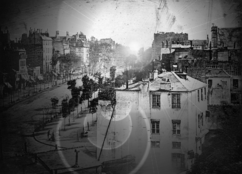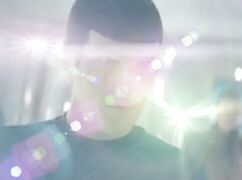Lens flare
Lens flare is an optical defect in which starbursts, polygonal rings or circles may show themselves in a row. Often the defect occurs due to a source of excessive dramatic awe or artistic flair, although it may often be artificially produced for no good reason whatsoever.
History
Humble origins
The concept of lens flare in photography originated with the very concept of using lenses in cameras. The first permanent photographic images, taken in 1830 by Louis Daguerre, were made using a single double convex lens coupled with a camera obscura. Unfortunately, such lenses were not as mature as modern lenses, and as such, they were easily distracted by stray light. This resulted in the first instances of lens flare in photography, as seen in the picture at right.
At first, photographers attempted to avoid lens flare; however, some visionaries decided to claim lens flare as what they dubbed "artistic effect". Gradually, people began to accept lens flare as a valid device for marking dramatic moments. Gradually, people also began to accept lens flare as a valid device for creating an illusion of dramatic tension for everyday, mundane moments.
A golden age
For the most part, lens flare saw a golden age into the latter half of the 20th century. Lens flare was a spectacular device for several reasons. For example, wherever lens flare was present, there was a sense of realism about the photograph; it did not seem as contrived or artificial. This was immensely helpful for photographers; now, any photographer wishing to generate an aura of spontaneity around a photograph never left the photograph to chance, but instead left it to lens flare.
The most important effect of lens flare, however, was perhaps that it was a great distraction from the supposed subject of a photograph or film. A bright, shiny, large lens flare made all the difference, especially if the photographer is actually terrible at directing his models. Fashion advertisements, therefore, started to make extensive use of lens flare.
Survival into the modern era
Later, however, it was re-discovered that lens flare was an optical defect rather than a deliberate effect. This fact had been neglected for some time, but lens manufacturers took notice, and started manufacturing lenses that were coated to prevent lens flare. New lens sales subsequently plummeted.
Recently, lens flare has entered a new golden age with several directors, such as J J Abrams and Michael Bay, making gratuitous use of the device. In fact, lens flare, despite its origins as a defect, has been given an important role in many artistic compositions, often given top billing over other A-list actors. To know why, an examination of lens flare's place in cinematic theory and usage is imperative.
Theory and usage
The use of lens flare in cinema splits filmmakers into two groups: the Sensible school, and the Stark Raving Mad school. The Sensible school of film views lens flare purely as an optical defect that is best avoided, choosing instead to focus on what is actually happening in the film.
The Stark Raving Mad school, however, could not differ more from this opinion. Filmmakers of this group believe that they must underscore and maximise the emotional and psychological impact of every dramatic fight, decision, contemplation, and silence by using a composition that completely distracts the viewer from the moment.
Examples
A prominent example of lens flare is found in the J J Abrams 2009 reboot of Star Trek. After Spock loses control of his emotions, an awkward pause ensues as Spock reflects on what he has done. Quinto's sideways gaze and forlorn expression clearly communicate his anguish and internal torment to the reader. The lens flare obscures this expression, distracts from clearly seeing the look in his eyes, but at least looks very pretty and shiny. Other examples in the movie include every other scene in it, as well as the opening titles and closing credits.

Another example is found in the recent Michael Bay movie Transformers: Revenge of the Fallen, which makes use of CGI lens flare as questionable as the movie's CGI robots. While lens flare intrudes in significant moments during action, death, and resurrection scenes, it clearly does not intrude enough since it fails to hide the fact that the movie itself is just awful.
Re-examination
Past works of cinema as well as still photography have been re-examined for realism and composition as measured by the degree of distraction provided by lens flare. The special effects of 2001: A Space Odyssey, for instance, have been praised in the past for their striking realism; however, modern producers have sagely detected the lack of lens flare that might distract from the scene of the alignment of the planets and the monolith. The striking scene of the binary sunset over Tatooine is undergoing the same restoration process in George Lucas's latest re-release of Star Wars. Entire portfolios of the works of Diane Arbus, Ansel Adams, and Jacob Riis are being re-examined as well.
As to the reason for these atrocities, a spokesman for Filmmakers for Lens Flare has admitted that "these flares add nothing to the composition or to the emotional or psychological impact of the still or moving picture, but still, it looks awesome."
Prevention
Despite the pseudo-scientific truth that lens flare is almost entirely inevitable in dramatic moments, many are attempting to stop the abuse of lens flare. For example, here is one criticism of lens flare after the making of the recent reboot of Star Trek, from someone inside the process:
| “ | There are [sic] something about those flares ... Our DP would be off camera with this incredibly powerful flashlight aiming it at the lens ... Sometimes ... literally, it was ridiculous. It was like another actor in the scene... | ” |
—J. J. Abrams, realising what he hath wrought | ||
Cinematographers and movie reviewers alike have become weary of these flares, and are now urging producers to "for the love of Pete, get a lens hood or buy newer lenses." Whether these campaigns are at all effective is yet to be seen.
See also
| Film world: | Academy Awards ♦ AFI (American Film Institute) ♦ Bollywood ♦ Film colorization ♦ Golden Raspberry Awards ♦ Hays Code ♦ Horny Awards ♦ Internet Movie Database ♦ Lens flare ♦ Roger Ebert ♦ Screenwriting ♦ Gene Shalit ♦ UnReviews |
| Studios: | 20th Century Fox ♦ Disney ♦ DreamWorks ♦ MGM ♦ Paramount ♦ Pixar ♦ Sony Pictures ♦ United Artists |
| Narrators: | David Attenborough ♦ Morgan Freeman ♦ Movie Trailer Announcer Guy |
| Types: | Albanian interpretationalist cinema ♦ B-movie ♦ Cult film ♦ Film noir ♦ Independent film ♦ Parody film ♦ Sequel ♦ Snuff film ♦ Western |
| Featured version: 12 August 2010 | |
| This article has been featured on the main page. — You can vote for or nominate your favourite articles at Uncyclopedia:VFH. | |





